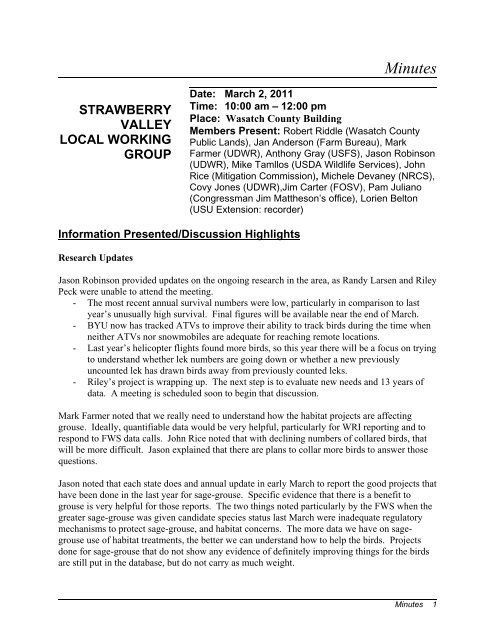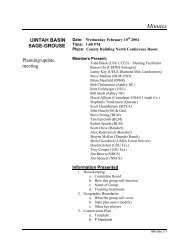Minutes - Utah CBCP
Minutes - Utah CBCP
Minutes - Utah CBCP
You also want an ePaper? Increase the reach of your titles
YUMPU automatically turns print PDFs into web optimized ePapers that Google loves.
<strong>Minutes</strong><br />
STRAWBERRY<br />
VALLEY<br />
LOCAL WORKING<br />
GROUP<br />
Date: March 2, 2011<br />
Time: 10:00 am – 12:00 pm<br />
Place: Wasatch County Building<br />
Members Present: Robert Riddle (Wasatch County<br />
Public Lands), Jan Anderson (Farm Bureau), Mark<br />
Farmer (UDWR), Anthony Gray (USFS), Jason Robinson<br />
(UDWR), Mike Tamllos (USDA Wildlife Services), John<br />
Rice (Mitigation Commission), Michele Devaney (NRCS),<br />
Covy Jones (UDWR),Jim Carter (FOSV), Pam Juliano<br />
(Congressman Jim Mattheson’s office), Lorien Belton<br />
(USU Extension: recorder)<br />
Information Presented/Discussion Highlights<br />
Research Updates<br />
Jason Robinson provided updates on the ongoing research in the area, as Randy Larsen and Riley<br />
Peck were unable to attend the meeting.<br />
- The most recent annual survival numbers were low, particularly in comparison to last<br />
year’s unusually high survival. Final figures will be available near the end of March.<br />
- BYU now has tracked ATVs to improve their ability to track birds during the time when<br />
neither ATVs nor snowmobiles are adequate for reaching remote locations.<br />
- Last year’s helicopter flights found more birds, so this year there will be a focus on trying<br />
to understand whether lek numbers are going down or whether a new previously<br />
uncounted lek has drawn birds away from previously counted leks.<br />
- Riley’s project is wrapping up. The next step is to evaluate new needs and 13 years of<br />
data. A meeting is scheduled soon to begin that discussion.<br />
Mark Farmer noted that we really need to understand how the habitat projects are affecting<br />
grouse. Ideally, quantifiable data would be very helpful, particularly for WRI reporting and to<br />
respond to FWS data calls. John Rice noted that with declining numbers of collared birds, that<br />
will be more difficult. Jason explained that there are plans to collar more birds to answer those<br />
questions.<br />
Jason noted that each state does and annual update in early March to report the good projects that<br />
have been done in the last year for sage-grouse. Specific evidence that there is a benefit to<br />
grouse is very helpful for those reports. The two things noted particularly by the FWS when the<br />
greater sage-grouse was given candidate species status last March were inadequate regulatory<br />
mechanisms to protect sage-grouse, and habitat concerns. The more data we have on sagegrouse<br />
use of habitat treatments, the better we can understand how to help the birds. Projects<br />
done for sage-grouse that do not show any evidence of definitely improving things for the birds<br />
are still put in the database, but do not carry as much weight.<br />
<strong>Minutes</strong> 1
<strong>Minutes</strong><br />
Updates<br />
Shape Files Updated<br />
Jason reported that UDWR now has updated shape files for winter and brood rearing habitat –<br />
available as a link from the Division’s sage-grouse web page – as well as a new category of<br />
shape file, “occupied habitat.” Lorien will send out the link to all the counties and groups. The<br />
shape files are of particular interest to counties since they can help with planning of<br />
developments.<br />
Proposed Powerlines<br />
The group reviewed the TransWest Powerline routing proposal currently being discussed in<br />
scoping meetings throughout the region. The group’s main concern was that the powerlines<br />
could provide raptor perches and increase predation concerns. Next week, Jason will be<br />
attending a tall structures working group that will consider those concerns. Overall, the<br />
TransWest powerline’s preferred route is acceptable to the sage-grouse group, as it will follow<br />
the existing corridor. The proposed Gateway South powerline may also come through Wasatch<br />
County, in the Soldier Summit area. That process is not as far along. Lorien and others will<br />
keep the group updated if Gateway South issues appear to be relevant to this working group.<br />
Development Concerns<br />
Jim Carter gave a presentation to the group about a large potential proposed development (the<br />
Strawberry Ranch Development) in the Strawberry Reservoir area, which could involve yearround<br />
residences and a large number of recreation opportunities, on 6600 acres of private ground<br />
near the reservoir. It might have implications for the lek if the project gets off the ground.<br />
Currently, formal proposals to the county with regard to the housing/recreation portion of the<br />
development are waiting on the development of an appropriate access road, which involves<br />
discussions with the Bureau of Reclamation, Wasatch County, Forest Service, and others. NEPA<br />
for the road is ongoing. The development could, if realized, bring substantial traffic and<br />
recreation use to the area, particularly during seasons when that has not been a concern for sagegrouse<br />
in the past. Jim will keep the group updated with any relevant details.<br />
County Presentations<br />
Jason and Lorien presented to the Public Lands Subcommittee of the Wasatch County Council.<br />
The three council members in attendance at the meeting had a number of questions and were<br />
appreciative of the information that was provided about sage-grouse in general, locally, and the<br />
work of the LWG, as well as a better understanding of the listing decision from last year.<br />
FOSV Info Request<br />
Friends of Strawberry Valley is a local group that coordinates information sharing between many<br />
<strong>Minutes</strong> 2
<strong>Minutes</strong><br />
Strawberry- area agencies and other interested parties, including the public. They have asked<br />
that SVARM produce a one-page description of the history and status of sage-grouse in the area,<br />
ideally with several pictures as well. The group provided many suggestions of places where<br />
some information has already been written. Lorien will draft a page and send it to the group for<br />
any suggestions before providing it to the FOSV folks.<br />
UPCD Habitat Projects<br />
The Badger Hollow/Chicken Springs project will be flagged in July. This is a wildlife habitat<br />
improvement project and the area is not grazed. The Strawberry mowing proposed project<br />
needs more discussion to be very helpful to sage-grouse. Mark Farmer will get the original maps<br />
to Anthony Gray and continue those discussions.<br />
Predator Management<br />
Predator management starts in early March. This year, the only plans are for raven control<br />
(poisoned eggs). Some of the predator control is also related to the deer management unit in the<br />
area. Approximately 600 eggs per week is the Forest Service limit. Raven populations will be<br />
the focus of the control efforts, not just sage-grouse areas. Fruitland are raven concentrations<br />
will be a focus, so that fewer ravens make it to Strawberry to affect the sage-grouse.<br />
There are currently no plans to control red foxes. At the last meeting, it was noted that a private<br />
individual had taken a number of foxes, potentially complicating the research design that was<br />
going to look at the impact of not controlling foxes. Mike Tamllos explained that the 24<br />
privately trapped foxes were most likely dispersing individuals, not established pairs. Their<br />
presence probably indicates that the number of dens in the area in increasing again, after<br />
intensive efforts by USDA-WS from 2003 to 2008 to reduce the number of dens. The number of<br />
dens found each year diminished steadily from 7 in 2003 to 1 in 2008. Best estimates of current<br />
population numbers are only best estimates because there are not predator inventories beyond<br />
what WS learns during the control efforts.<br />
Field Tour Planning<br />
Ideas for the summer field tour included:<br />
- Getting Wasatch County Council members out to the chaining sites to help them<br />
understand how chainings can benefit wildlife<br />
- History of the Strawberry grouse populations and research<br />
- Co-op creek to look at the impact snow machines make<br />
- Trout Creek to look at the forb recovery and weed issues several years out<br />
- Chicken Springs to look at a more recent project<br />
- A tour in June if we want to have a vegetation focus, or in August if we are interested to<br />
see the machines actually doing treatments<br />
<strong>Minutes</strong> 3
<strong>Minutes</strong><br />
Follow-up Needed<br />
- Lorien will send a link to the updated sage-grouse habitat GIS shape files to the group<br />
and the county.<br />
- Lorien will draft a one-page look at history and status of local sage-grouse for FOSV<br />
- Mark and Anthony will coordinate to improve project design for the Strawberry mowing<br />
project proposed through UPCD for WRI funding<br />
- DWR will coordinate with BYU to discuss habitat project evaluation needs as part of<br />
future research design goals<br />
NEXT MEETING: April 27, 2011<br />
<strong>Minutes</strong> 4





